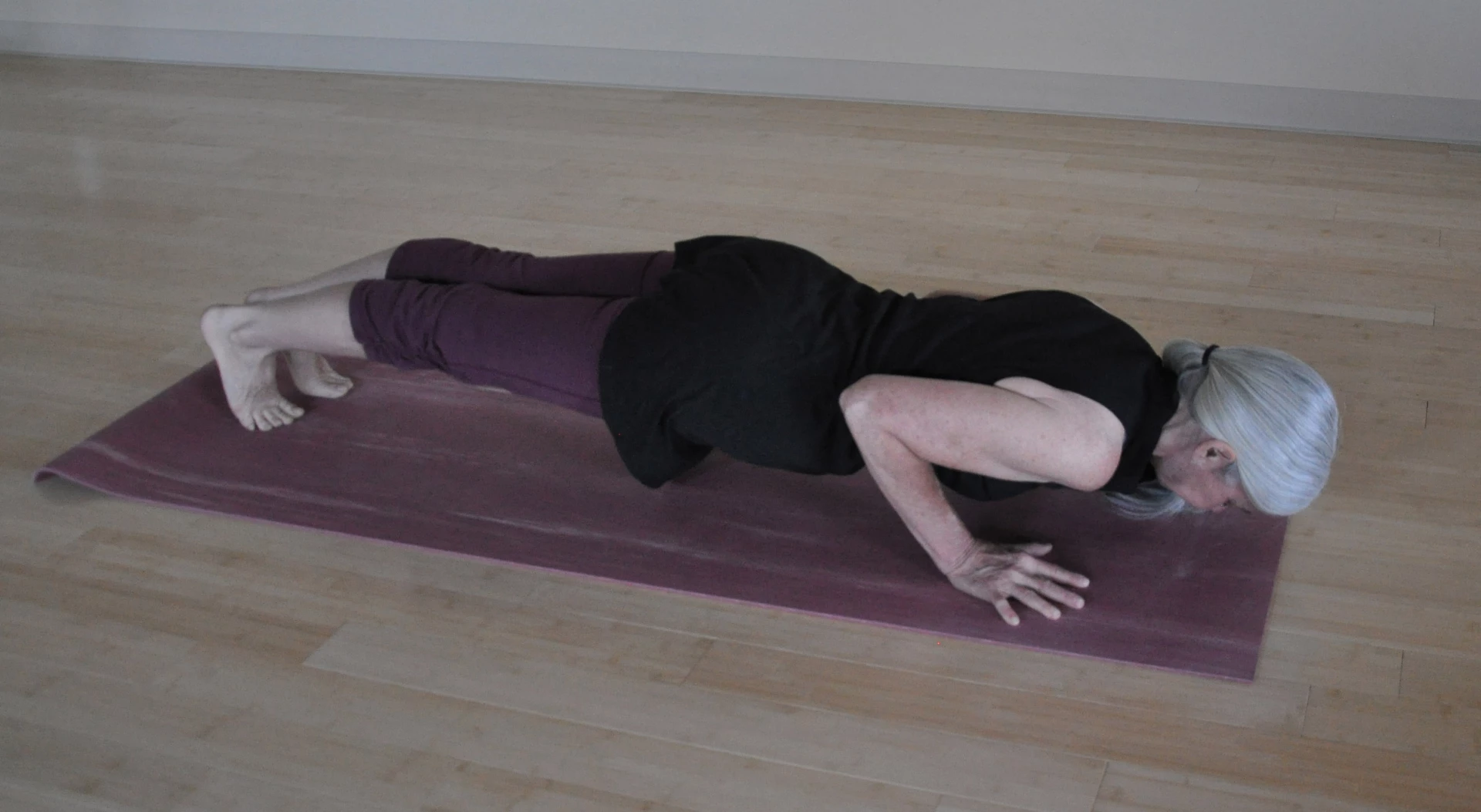Help from Your Hyoid: Safe Alignment in Chaturanga Dandasana

What’s an eight-syllable Sanskrit name that, when spoken by a yoga teacher, elicits fear (or at least, a groan) in roughly half the population that practices yoga? The same phrase that evokes a feeling of invincible awesomeness in many others. The answer: Chaturanga Dandasana (Four-Limbed Staff Pose).
Strengthening the Upper Body with Chaturanga
Chaturanga looks like a push-up, but it’s not a push-up. It is primarily practiced as a transition pose in Sun Salutations, often between Downward Facing Dog and Upward Facing Dog or Cobra. Chaturanga requires a great deal of upper body strength, and therefore, it also builds the upper body. In addition, it builds core strength, especially if you engage a funny little structure called the hyoid bone while you practice it.
How the Hyoid Bone Affects Yoga Pose Alignment
The hyoid bone is the human version of the wishbone. It’s a small, u-shaped bone in the front of your neck that sits just below your chin and above your thyroid cartilage. Place your right thumb on the right side of your neck just below your chin and your index finger on the left side. You can feel the ridges on its surface if you palpate the area. Because it is the only bone in the body that is not attached to another bone it is quite mobile. If you press on it from the right, you will feel the left side pushing out against your index finger and vice versa. Its primary functions are to help move the tongue and to facilitate swallowing.
The position of this little bone powerfully affects your posture. If your chin and hyoid bone are jutting forward or your head is tilting back, your entire core—internal structures such as your organs—will push forward into your abdominal wall. When you draw your hyoid back, lengthening the back of your neck and lifting the base of your skull, your organs and abdominal wall draw back giving frontal support to your spine.
How to Approach Chaturanga Dandasana
So what does this have to do with Chaturanga? If you are jutting your chin out and throwing your head back in Chaturanga, your organs and abdomen will sag toward the ground, making the pose even more difficult as your arms fight the weight of your core. Drawing your hyoid back allows your core to lift up into your back body, stabilizing your yoga pose.
There are many ways to approach Chaturanga. Here’s one:
- Start in Downward Facing Dog on a nonskid mat.
- Draw your hyoid bone back so that the back of your neck lengthens. Maintain this position throughout.
- Now shift your whole body forward, keeping your pelvis higher than your shoulders.
- Roll your shoulders back so that your shoulder blades slide down your back.
- With your pelvis still high, bend your elbows, keeping them close to your sides.
- Only when your chest is a few inches from the floor should you bring your pelvis to level with the rest of your body, at least when you’re first starting to practice Chaturanga.
Here’s why: If you lower your pelvis too fast it will come to the floor first. Once it’s on the floor it’s really difficult to lift it back up to level. So if you find your pelvis reaching the floor before your elbows are fully bent, return to Dog Pose and start over, keeping your pelvis high in the air.
Once you’re in the pose, turn your toes under and lengthen back through your heels, actively lifting your legs upward. Simultaneously lengthen through the top of your head in the opposite direction. Take a few breaths before coming to rest on the ground or moving into Down Dog or Cobra.
Four-Limbed Staff Hand Placement
Opinions on hand placement abound. The most popular alignment “rule” is that your forearms should be vertical in this pose, but if your humerus bones are extra long—like mine are—this alignment is inefficient. I encourage students to experiment with their hand placement—anywhere from underneath the chest to under the lower ribs.
Modifications & Tips for Chaturanga Yoga Pose
If Chaturanga is just not happening for you—and in the interest of full disclosure, I confess that it took me a year to be able to hold myself up in the pose—here’s another approach: Place a yoga block flat on the floor underneath your pelvis. Starting with your chest high, bend your elbows into Chaturanga position, press your hands into the floor and activate your legs. Remember your hyoid bone. You may find your pelvis lifting a millimeter or two off the block. This variation helps train your upper body and allows you to understand what an aligned pose feels like even if your upper body is not ready to hold you up.
The most helpful skill in learning Chaturanga is patience. It can take a long time to build the upper body strength and alignment to practice efficiently. If you regularly practice Chaturanga in a fast-paced vinyasa class, take care not to overdo it. More is not always better. Rather, practice with care and remember that the freedom available to you in any pose depends on the quality of your attention, not what your pose looks like.
 Charlotte Bell began practicing yoga in 1982 and began teaching in 1986. She was certified by B.K.S. Iyengar in 1989 following a trip to Pune. In 1986, she began practicing Insight Meditation with her mentors Pujari and Abhilasha Keays. Her asana classes blend mindfulness with physical movement. Charlotte writes a column for Catalyst Magazine, and is the author of two books:Mindful Yoga, Mindful Life and Yoga for Meditators, both published by Rodmell Press. A lifelong musician, she plays oboe and English horn in the Salt Lake Symphony and the folk sextet Red Rock Rondo whose 2010 PBS music special won two Emmys.
Charlotte Bell began practicing yoga in 1982 and began teaching in 1986. She was certified by B.K.S. Iyengar in 1989 following a trip to Pune. In 1986, she began practicing Insight Meditation with her mentors Pujari and Abhilasha Keays. Her asana classes blend mindfulness with physical movement. Charlotte writes a column for Catalyst Magazine, and is the author of two books:Mindful Yoga, Mindful Life and Yoga for Meditators, both published by Rodmell Press. A lifelong musician, she plays oboe and English horn in the Salt Lake Symphony and the folk sextet Red Rock Rondo whose 2010 PBS music special won two Emmys.



